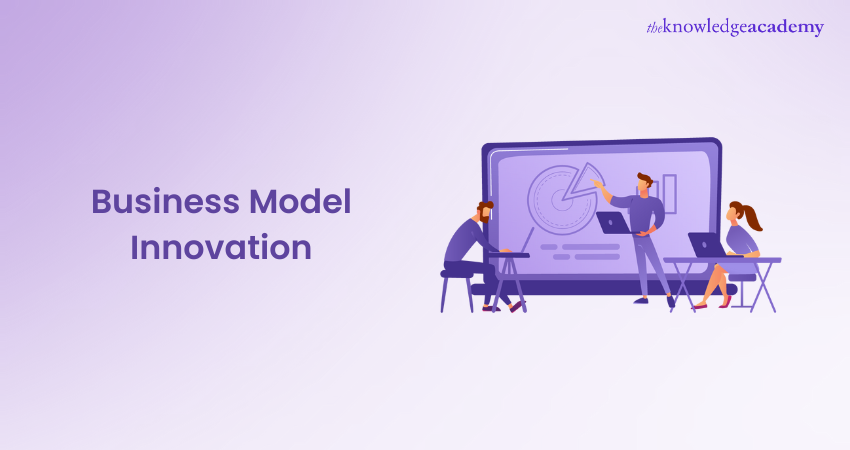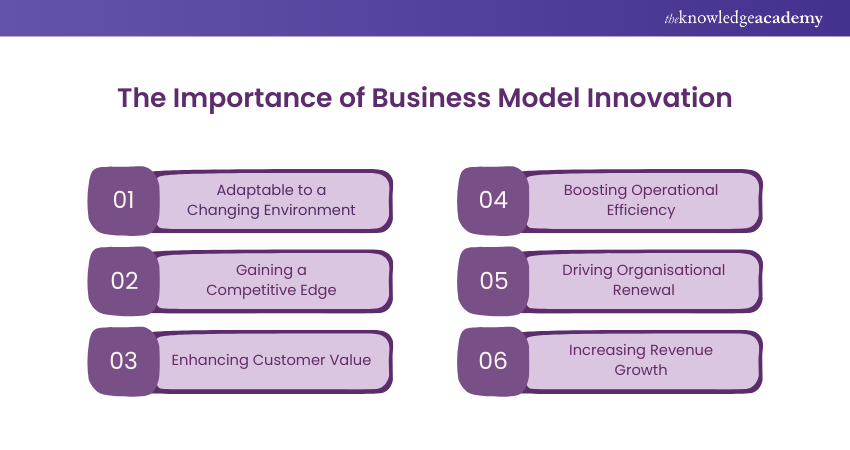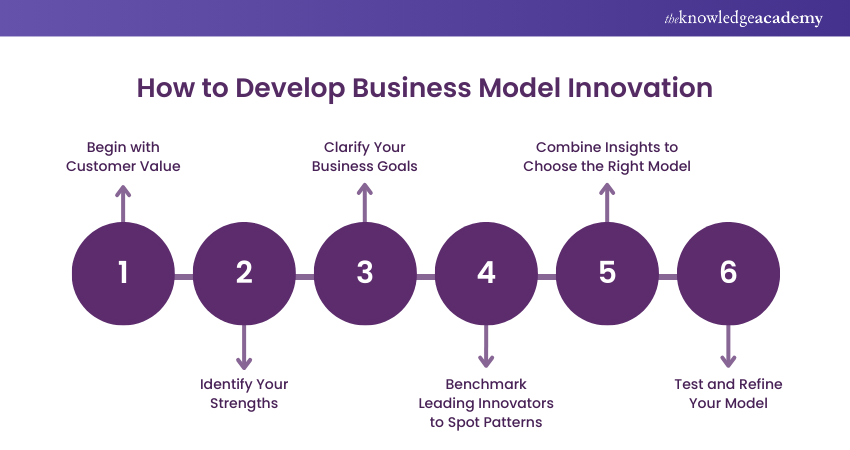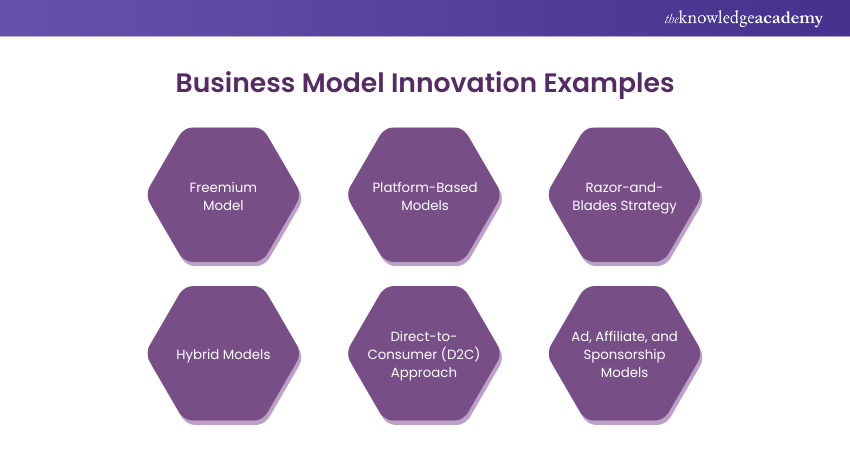We may not have the course you’re looking for. If you enquire or give us a call on +44 1344 203 999 and speak to our training experts, we may still be able to help with your training requirements.
Training Outcomes Within Your Budget!
We ensure quality, budget-alignment, and timely delivery by our expert instructors.

Business Model Innovation is not a term anymore; it's a necessity for the evolving industry. Think of Netflix, which was merely a DVD rental service in 1997 and has transformed into the world's most subscribed video-on-demand over-the-top streaming service today. The Business Model Innovation holds infinite scalability today that has largely influenced how businesses adapt to innovation and profitability. In this blog, you will explore the intricacies of Business Model Innovation, its importance, how to develop it, and prominent examples that led to the rise of this revolutionary discipline.
Table of Contents
1) What is Business Model Innovation?
2) The Importance of Business Model Innovation
3) How to Develop Business Model Innovation?
4) Examples of Business Model Innovation
5) Best Practices for Implementing Business Model Innovation
6) Conclusion
What is Business Model Innovation?
Business Model Innovation comes from three words: business, which means any enterprise that works for attaining profits; model, particular framework businesses follow to reach that profit; and Innovation, meaning, aligning with market trends.
To sum up, Business Model Innovation is a strategy that signifies how businesses deliver value to their customers. In simple words, it's the framework businesses follow to fulfil the client's demands and expectations while aligning with the latest technologies and market trends. The examples of such a framework could include developing newer products, modifying existing products, and altering or diversifying profitability.

The Importance of Business Model Innovation
Numerous implications are associated with Business Model Innovation considering the modern corporate ecosystem. Here are those listed significance:

1) Adaptable to a Changing Environment
Business Model Innovation (BMI) is key for businesses to stay relevant and successful in today's fast-paced market. It helps businesses to stay adaptable, meet customers' demands regularly, and enhance their overall efficiency and productivity.
2) Gaining a Competitive Edge
It lets you stay ahead in the competitive market. By consistently introducing newer products and innovation, your brand gains significant influence on customers, helping you remain better against competitors.
3) Enhancing Customer Value
Business Model Innovation allows companies to deliver greater value to their customers. By regularly creating newer products, you can boost customer retention rates, an asset in today's corporate market.
4) Boosting Operational Efficiency
Improving the way how businesses improve their clients' experience through streamlining processes can save considerable time and money, enhancing their overall operational efficiency.
5) Driving Organisational Renewal
As companies grow, businesses need to refine and reinvent themselves. By doing so, they can refresh their strategies and approach, ensuring they stay modern and relevant to the current market ecosystems.
6) Increasing Revenue Growth
Business Model Innovation helps businesses discover new ways to improve their profit. By diversifying and altering their revenue streams, companies can achieve significant economic as well as their reputational growth.
Innovate business solutions with design thinking- kickstart our Design Thinking Course today!
How to Develop Business Model Innovation?
Developing Business Model Innovation (BMI) is essential for companies to stay competitive and relevant. Here’s a simple overview to help you create an innovative business model:

1) Begin with Customer Value
Start by focusing on your customers' intents. Understand what they need and value the most. This will help you shape a model that truly meets their expectations, improving overall customer satisfaction.
2) Identify Your Strengths
Look at what your company does best. Whether it's cutting-edge technology, excellent service, or efficient operations, building your model around these strengths ensures you stay relevant to your advantage.
3) Clarify Your Business Goals
Know what you want to achieve. Setting clear, measurable SMART business goals help navigate your innovation efforts and ensures your model remains consistently aligned with your long-term objectives.
4) Benchmark Leading Innovators to Spot Patterns
Study successful companies that have excelled in innovation. Learn from their strategies and see what patterns or trends you can apply to your business model.
5) Combine Insights to Choose the Right Model
Blend what you have learned from customer insights, strengths, and benchmarks to create a business model that fits your company. Choose the approach that best serves your goals and customer needs.
6) Test and Refine Your Model
Don’t stop once you’ve developed a new model. Test it in real-world situations, gather feedback, and make necessary adjustments. Continuous improvement is key to staying innovative.
Examples of Business Model Innovation
Understanding different business models enables companies to stay innovative and competitive. Here are some simple yet popular and effective examples of popular Business Model Innovations:

1) Freemium Model
The freemium model comes from 'free' and 'premium', which means a hybrid business model offering both free and paid services. Businesses often implement this model to provide free access to their basic services while charging for advanced services. Key examples include Spotify and LinkedIn.
2) Platform-Based Models
A platform-based model is where companies connect sellers with their buyers and vice-versa on a single online platform. These platforms provide a space for users to engage without holding inventory themselves. Prominent examples include e-commerce sites like Amazon, Flipkart, eBay, and Airbnb.
3) Razor-and-Blades Strategy
The razor-and-blade strategy involves companies delivering their main products at lower costs while charging for additional accessories. Gillette, a razor manufacturing brand, commonly have utilises this model succesfully (therefore, the name Razor-and-blade). They sell their razors at lower or no cost (providing them as a free product with their other product) while charging significantly for blades. This helps generate leads while keeping customers retained for a longer time.
4) Hybrid Models
Hybrid models merge multiple revenue streams or business strategies. A company might offer a package of products and services together, allowing for flexibility and diversification in their income streams. For example, a software company may sell their licenses while also providing consulting services.
5) Direct-to-Consumer (D2C) Approach
The direct-to-customer (D2C) approach connects the primary company, such as a manufacturing company, directly with its customers without a retailer or a middle person holding a portion of the profit. This allows companies to communicate directly with their audiences and work on their feedback while earning higher profits. Companies like Warby Parker and Dollar Shave Club are among the prestigious brands that have already implemented this Business Model Innovation strategy successfully.
6) Ad, Affiliate, and Sponsorship Models
These models generate revenue through advertisements, affiliate marketing, or sponsorships. For instance, companies may provide free content or services while earning money from brands that want to reach their audience. Websites and social media platforms, such as YouTube, often use this strategy. YouTube enables itself to deliver how creators earn money from ads and sponsorships.
Drive transformative change with our Agile Leadership Training- join today!
Best Practices for Implementing Business Model Innovation
Implementing Business Model Innovation (BMI) requires a structured approach to ensure long-term success and robust brand reputation among customers. Here are some best practices to navigate you through the process:
1) Foster a Culture of Innovation: Create a work culture where ideas are openly shared, and experimentation becomes a daily task. This openness stimulates creativity and helps identify unique solutions, helping the organisation significantly boost its customer value and operational efficiency. Moreover, you must also consistently conduct brainstorming sessions and innovation workshops to stay up-to-date on this culture.
2) Prioritise Customer Feedback: Engage with customers directly regularly by answering their comments and queries on their social media channels and official websites. Utilise surveys, focus groups, and forms to gather their feedback, allowing the company to make informed decisions.
3) Leverage Data and Analytics: Analyse performance metrics to track the effectiveness of the new model. Review these metrics regularly to identify improvement areas and ensure the implemented strategies are in line with business goals and market demands.
4) Adopt an Iterative Approach: Start with a pilot program or a minimum viable product (MVP) to test assumptions and learn from real-world interactions. This approach allows for refinement before a full-scale rollout, thus allowing greater flexibility and adaptability to lay the robust foundation for long-term success.
5) Ensure Cross-Functional Collaboration: Promote collaboration across different departments to leverage diverse expertise and perspectives. This holistic approach can promote better comprehension and innovative solutions. Conduct regular cross-functional meetings and collaborative platforms to facilitate better team communication and coordination.
Transform complex problems into opportunities- join our Creative And Analytical Thinking Training today!
Conclusion
We hope you understand What is Business Model Innovation. By utilising various innovative models, organisations can not just improve their customer value, but boost their operational efficiency, and drive revenue growth effectively. Moreover, adopting best practices such as fostering an innovative culture and prioritising customer feedback ensures successful implementation of your target strategies and enable sustained competitive advantage.
Unlock advanced AI applications in leadership roles with our Certified Artificial Intelligence For Leaders Training- register now!
Frequently Asked Questions

The success of any Business Model Innovation relies on how well you understand your customers' needs, leverage data analytics, adapt to the innovative culture, promote agile methodologies, and constantly work on client feedback. By implementing these strategies, you can ensure long-term success while creating brand value in the corporate market.

The four elements of Business Model Innovation are value proposition, customer segmentation, revenue streaming, and outlining the critical activities and resources.

The Knowledge Academy takes global learning to new heights, offering over 30,000 online courses across 490+ locations in 220 countries. This expansive reach ensures accessibility and convenience for learners worldwide.
Alongside our diverse Online Course Catalogue, encompassing 19 major categories, we go the extra mile by providing a plethora of free educational Online Resources like News updates, Blogs, videos, webinars, and interview questions. Tailoring learning experiences further, professionals can maximise value with customisable Course Bundles of TKA.

The Knowledge Academy’s Knowledge Pass, a prepaid voucher, adds another layer of flexibility, allowing course bookings over a 12-month period. Join us on a journey where education knows no bounds.

The Knowledge Academy offers various Leadership Courses, including Business Model Innovation Training, Design Thinking Course, and Certified Artificial Intelligence For Leaders Training. These courses cater to different skill levels, providing comprehensive insights into B2B Business Development Strategies.
Our Business Skills Blogs cover a range of topics related to business management and development, offering valuable resources, best practices, and industry insights. Whether you are a beginner or looking to advance your professional skills, The Knowledge Academy's diverse courses and informative blogs have got you covered.
Upcoming Business Skills Resources Batches & Dates
Date
 Business Model Innovation Training
Business Model Innovation Training
Fri 4th Oct 2024
Fri 3rd Jan 2025
Fri 28th Mar 2025
Fri 23rd May 2025
Fri 4th Jul 2025
Fri 5th Sep 2025
Fri 24th Oct 2025







 Top Rated Course
Top Rated Course


 If you wish to make any changes to your course, please
If you wish to make any changes to your course, please


